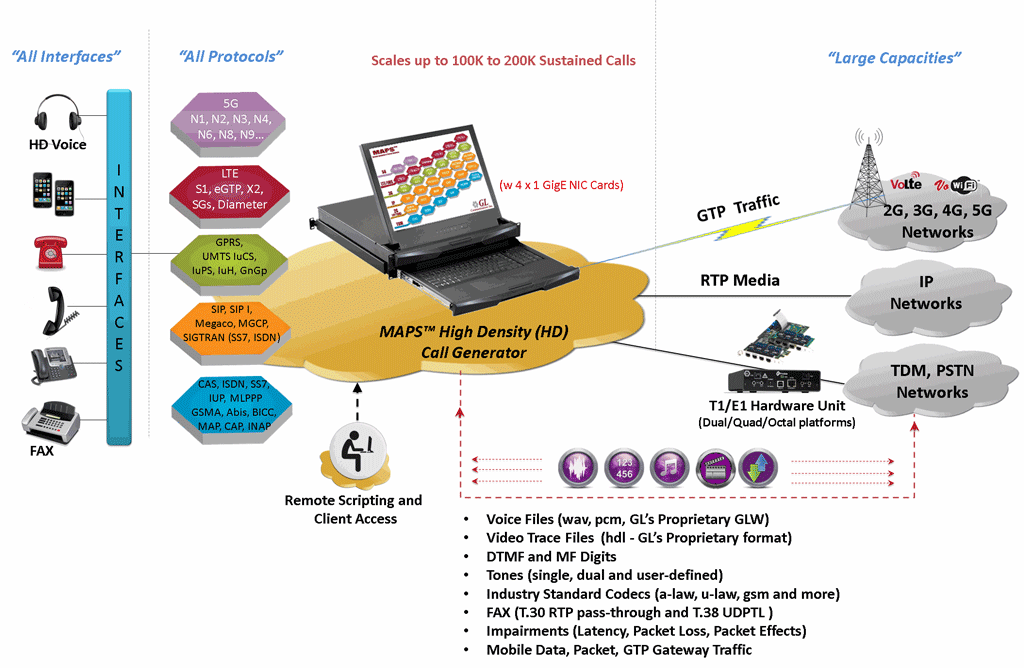Traffic Generation Software for Analog, TDM, IP, & Wireless Networks
Gaithersburg, Maryland, USA - April 26, 2013- GL Communications Inc. announced today its latest testing tool Traffic Generation Software for Analog, TDM, IP and Wireless Networks.

Speaking to reporters, Mr. Vijay Kulkarni, CEO of the Company said, "As traffic intensity increases, network elements (including switches and transmission) can impart various impairments such as errors, excessive delay, congestion, blocking, loss, and degraded quality. Simulating traffic can be valuable to characterize the impairment as a function of traffic intensity and traffic type (e.g. Voice, Fax, Data, Video).
GL's Protocol Emulator platform MAPS™ (Message Automation and Protocol Simulation) performs signaling and traffic generation for a vast array of communication protocols covering IP, Analog, TDM, and Wireless Networks. Examples include testing legacy networks (which use conventional signaling such as CAS, SS7, ISDN..), newer generation IP Networks (using SIP, MGCP, MEGACO, SIGTRAN, Diameter..), and Wireless Networks (using GSM, GPRS, UMTS, and LTE)."
He explained, "MAPS™ supports transmission, detection, and capture of various TDM and Analog traffic such as, digits, voice files, single tones, dual tones, and fax after call establishment. The volume of calls can vary from one to hundreds of calls depending on the T1 E1 or Analog platform of choice. MAPS™ series products for TDM are: MAPS™ ISDN, MAPS™ SS7, MAPS™ GSM A, and MAPS™ CAS.
MAPSTM CAS includes FXO FXS, R1, MFC-R2, and other variations for both analog 2wire and T1 E1 – for hundreds of channels. Fax traffic over 2wire analog and T1 E1 is supported for all variations of fax, such as page size, resolution, min & max data rate, and codec type – including high speed fax such as V.34.
For GSM, TRAU (Transcoder Rate Adapter Unit) traffic simulation is included with options to create, monitor, and terminate TRAU GSM traffic sessions supporting Tx / Rx of DTMF digits, files, and tones after session establishment."
Mr. Kulkarni further explained, "MAPS™ supports transmission and detection of various RTP traffic such as digits, voice files, single tone, and dual tones after call establishment. These features are applicable for GL's MAPS™ series products: MAPS™ UMTS IuCS, MAPS™ UMTS IuH, MAPS™ GSM AoIP, MAPS™ SIP, MAPS™ SIP I, MAPS™ MEGACO, and MAPS™ MGCP, among others. Traffic actions include: Loopback real-time voice traffic (all received traffic is retransmitted as sent traffic), "Play to Speaker" streams voice of a selected call to a speaker, Talk using Microphone – allows the user to generate real-time traffic, Transmit pre-recorded voice files on the specified RTP sessions and more.
Mobile Traffic Simulation module within MAPSTM supports user plane traffic simulation for LTE, UMTS and GPRS networks. Mobile Traffic Simulation is supported in MAPS™ LTE S1, MAPS™ LTE eGTP, MAPS™ UMTS Gn Gp, and MAPS™ IuPS and MAPS™ GPRS Gb applications. It includes following modules:Packet Traffic Simulation, Mobile Traffic Core - GTP, Mobile Traffic Core - Gateway,Mobile Traffic Simulation - GPRS Gb.
MAPS™ supports sending and receiving SMS (Short Message Service) using the signaling channel simultaneous with other voice and data services over GSM or MAP interfaces. It has the ability to push / pull Short Messages over the network as if sent by thousands of mobile phones (Short Message Mobile Originated (SMS-MO)).
In addition to GUI operation, MAPS™ can also be operated through a Command Line Interface (CLI). All the GUI based functionalities can be controlled remotely. Traffic simulation on a local network as well as from a remote location is possible with the client interface.
Scripting provides the ability to create ready-scripts for TDM and RTP traffic simulation. Various traffic events are applied during the course of a call."
 Back to Press Releases Index Page
Back to Press Releases Index Page